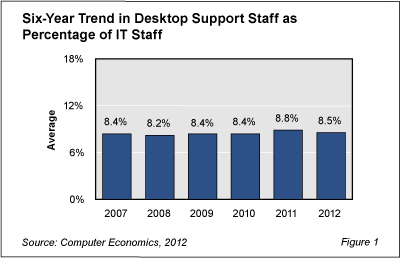Over the past six years, desktop support staffing levels have remained surprisingly constant as a percentage of the IT staff. Neither the growing level of sophistication of first-call support nor the increasing array of client systems being deployed in many IT environments has moved the needle on the relative size of IT staff dedicated to providing technical support to end users.
Our study, Desktop Support Staffing Ratios, finds that the desktop support staff across all sizes of organizations remained at about 8.4% from 2007 to 2010, rose to 8.8% in 2011, and then returned to the 8.5% level in 2012, as shown in Figure 1. This study is based on our annual IT benchmarking survey of more than 200 IT organizations in each year.

Compared with the early days of the PC, today’s desktop computers are more reliable, users more knowledgeable, and tools for managing PCs more robust. Yet these machines still require a great deal of support to maintain high levels of user satisfaction and productivity, and the need for mobility, security, and connectivity make support needs as great as ever.
The term “desktop support” requires definition. In some organizations, desktop support refers to personnel who are present on-site to help users with PCs, network connectivity, telephones, and perhaps other equipment. We use a functional definition. Regardless of whether they are located in a distant call center or an office down the hall, desktop support staff members by our definition assist users with technical issues related to PC hardware and operating systems. While organizations requiring a higher level of service may prefer on-site support, many desktop support functions today can be handled remotely.
Desktop support refers to all technical support activities related to PC systems, including desktops, notebooks, and workstations of all types. In most companies, these include activities such as building or setting up new machines, initial installation of operating systems and standard application software, applying periodic updates and security patches, replacing and disposing of obsolete equipment, monitoring PC usage, and responding to user-reported incidents involving PC systems. In some cases, desktop support personnel also may be supporting printers, LANs, whiteboards, telephones, conference room projectors/displays, or other user equipment.
The full study also provides benchmarks on typical desktop support staffing. We use two metrics to benchmark desktop support staffing: desktop support staff as a percentage of the IT staff and PCs per desktop support staff member. We also assess these ratios by organization size and sector. In addition, we provide benchmarks for organizations with combined desktop support and help desk functions. We conclude with strategies for improving the efficiency of desktop support staff.
This Research Byte is a brief overview of our report on this subject, Desktop Support Staffing Ratios. The full report is available at no charge for Computer Economics clients, or it may be purchased by non-clients directly from our website (click for pricing).
Do you also need staffing ratios for other IT job functions? Consider this collection of all of our staffing ratio reports, which bundles them all into a single report at a significant discount: IT Staffing Ratios–Special Report Bundle.

